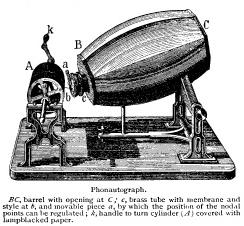 One curious note about the first-ever recording I mentioned today: you’re among the first to hear it, because at the time, the inventor had worked out how to record, but not how to play anything back. (No speakers — no sound.) It did make awfully nice pictures of sound, though, which in turn suggests an interesting idea for a recording device now: a microphone, an image, but no playback.
One curious note about the first-ever recording I mentioned today: you’re among the first to hear it, because at the time, the inventor had worked out how to record, but not how to play anything back. (No speakers — no sound.) It did make awfully nice pictures of sound, though, which in turn suggests an interesting idea for a recording device now: a microphone, an image, but no playback.
The basic technology of the phonautograph: make an image of the sound using a hog bristle, not unlike the way CDs work with lasers for optical storage (albeit with digital, not analog information), or the image produced in an optical sound track in film. (If you feel bad for the hog, wait until you get to the end of this story.)
More on the phonautograph, including details from the folks who brought us FireWire (IEEE 1394):
IEEE Virtual Museum: The Phonautograph
Wikipedia: Phonograph (and, specifically, its roots in the phonautograph)
Leon Scott, the inventor
Here’s the strange part of the story: Alexander Bell had his own twist on the phonautograph, via the IEEE Virtual Museum:
…one of Bell’s associates supplied him with the ear and part of the skull of a dead man. Bell attempted to attach a recording stylus to the ear and use it to inscribe a line on a smoked-glass plate. … It worked, and when Bell shouted into the dead man’s ear, the stylus recorded his speech on the glass.
Yes, that’s one way to get your transducer: steal it from a dead person. I had no idea Dr. Bell had a Dr. Frankenstein side.
I’m sure there’s a digital, interactive installation piece just waiting to be inspired by this. Please refrain from using an actual dead person, okay? That’s creepy. Now there’s an iPod alternative…